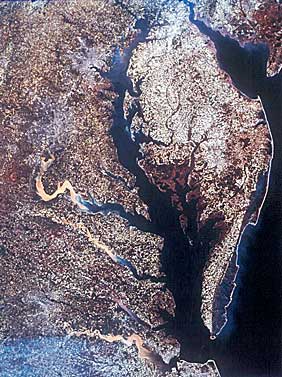Chesapeake Bay | |
|
The Chesapeake Bay is the largest estuary in North America and the second largest estuary in the world. The watershed covers 64,000 square miles and includes six states: Delaware, Maryland, New York, Pennsylvania, Virginia and West Virginia. From North to South the Bay is 195 miles long, the width of the bay ranges from 4 miles to 30 miles. The Bay and its tidal tributaries have over 11,000 miles of shoreline; this is more than the entire West coast. There are about 150 major rivers and streams that are in the Chesapeake drainage basin. The Susquehanna River provides half the amount of freshwater coming into the Bay. Chesapeake Bay has an average depth of 21 feet and the deepest part of the Bay is 174 feet. Its salinity ranges from completely freshwater in the northern part of the Bay to areas that are as salty as the ocean near the mouth of the bay. There are more than 15 million people that live within the Chesapeake Bay basin. The Bay serves as a commercial and recreational resource for those that live within the basin. Commercially, the Bay produces about 500 billion pounds of seafood a year, it is one of the largest sources for seafood in America. The Estuary provides a habitat for over 2500 species of plants and animal life, including over 200 species of fish. The Chesapeake Bay also is home to two of the five major ports in North America. Baltimore, Maryland in the Upper Bay and Hampton Roads, Virginia in the Lower Bay. These ports are economically important to the communities that are part of the Chesapeake Bay area. The Estuary is so big that people living within the basin are only a few minutes from one of the rivers or streams that flow into the Bay. Therefore human activities on land have a substantial impact on the Bay. The Chesapeake Bay was the first estuary in the nation targeted for restoration due to human impact.
|
 Courtesy of Chesapeake Bay Foundation http://www.cbf.org |